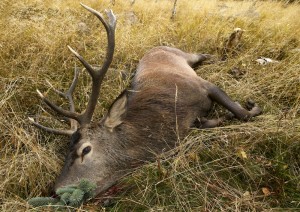Deep Dragging Basics for Deer
Before dragging the deer home the first thing that needs done is to field dress it. This both protects the meat and makes the deer lighter to drag. Don’t worry about parts left in the woods. Those parts feed hungry animals like the  coyotes and buzzards. They clean up the parts and mess in the woods. Once the deer has been field dressed, it’s time to drag that big buck or doe out of the woods.
coyotes and buzzards. They clean up the parts and mess in the woods. Once the deer has been field dressed, it’s time to drag that big buck or doe out of the woods.
Different hunters have different methods for packing their deer home. If hunting where ATV’s, deer carts, jeeps or trucks can get to it, then definitely load it up and drive it away. If not, the options are to hand carry/drag, get help to hand carry/drag, use a pole, make a litter/stretcher, or conceal the deer and come back later with help. Regardless of the way the deer is drug in, hunters need to at least have rope with them. It is recommended to have a tarp (about 3′ x 6′) or a poncho for easier extrication of the deer. Also the tarp or poncho offers a windbreak or shelter from the weather while hunting, or it can be used to sit on.
Hand dragging isn’t quite as hard as it sounds, but it is rough if going up hill, across creeks, through ravines or just going a long distance. For short drags it is recommended to pull the deer by its antlers or by the front legs.
For a more moderate drag, tie the front legs together and run the rope through the base of the antlers. Do not place the rope around the neck of the deer to drag, especially if planning on taking the head to the taxidermist to have mounted. The rope will cut, tear and scar up the neck and head area as it is pulled across the ground.
The long difficult deep drag is a bit trickier. For a long or uphill drag, first try to get help. If no help is available then make a litter or stretcher to drag the deer on. If help is available then use poles or litter to carry it out.
When making a litter for deep dragging a deer, a poncho or tarp (brown, grey or camouflage in color) and a length of rope is needed. You also need two fairly straight tree limbs or poles. Open the tarp and lay it flat on the ground. Lay two poles or tree limbs lengthwise across the poncho or tarp with excess fabric at the top of the two poles. Now lay the two poles across the tarp so that it is divided into three equal portions. Pull top section of fabric down over the poles and the rest of the tarp. Make sure no drawstrings or ropes are hanging loose. Fold one outer third of the tarp over the pole on that side, then fold the other outer third over the pole on the other side. Roll the deer onto the litter drag. The weight of the deer keeps the litter from parting as you drag it.
If no poncho or tarp is available, but help is, then find a long tree limb. Tie the front feet together and tie the back feet together. Run the tree limb through the front and back tied feet and hoist the limb up onto your shoulder and your helper’s shoulder. Start carrying. This keeps the deer from dragging on the ground and rocks, and helps preserve the hide for tanning.
Another way to pack deer out of the woods is backpacking. This method is used more for mule deer than for the white-tailed deer. Backpackers pack their gear into the woods on their backs in packs. Ideally the supplies will be consumed and used, thus making room for the deer meat to be packed out. Hunters field dress, skin, and quarter the deer in the woods. The meat is then placed into white deer meat bags and placed into backpacks to tote out of the woods.
Regardless of which method used to drag a deer out of the woods, it is an exhausting yet exhilarating experience. Trial and error help determine which method a hunter prefers.
